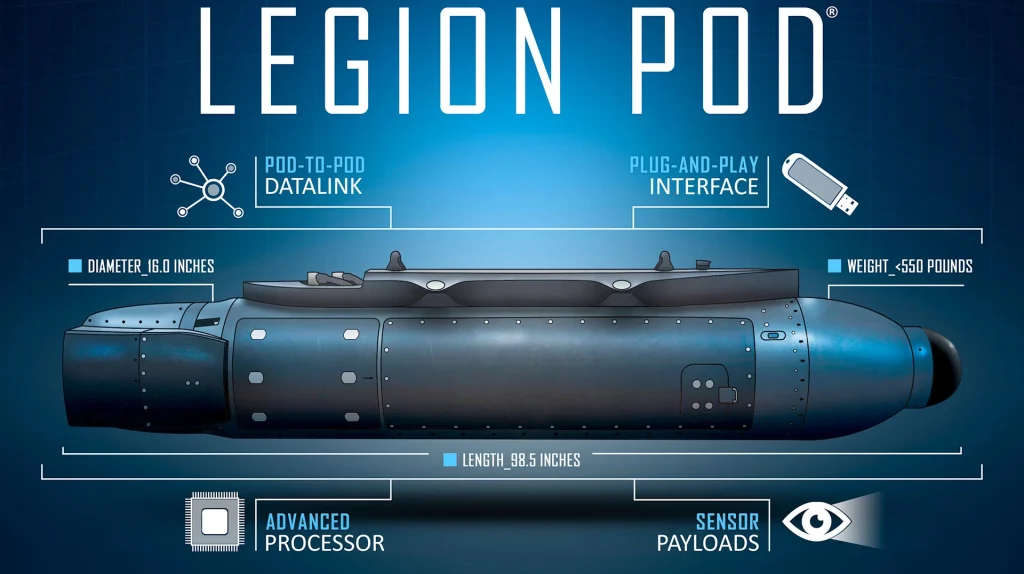The Legion pod developed by the Lockheed Martin company has achieved Initial Operating Capability (IOC) on the U.S. Air Force’s F-15C fighter jets. This infrared technology allows pilots to monitor enemy activity without resorting to the fighter’s radar and thus warn of their presence.
Likewise, its passive operation prevents its F-15s radar from being disturbed or jammed by adversary systems, allowing aircraft to operate in electronically congested environments. The U.S. Air Force expects to achieve full operational capability (FOC) later this year on the F-15C, which can be integrated into other fighters such as the F-16 or F-15X.
As per the U.S. Air Force, “The IRST pod, known as the Legion Pod, is a sensor that uses the infrared spectrum to help pilots to track and engage enemy aircraft in environments, where traditional radar technology is denied. The pod also provides a way of monitoring enemy aircraft from extended ranges that normally go undetected, boosting the effectiveness of the F-15C and its ability to dominate the battlespace.”
The Legion Pod
The U.S. company Lockheed Martin was selected in 2017 to supply its Legion pod to equip the F-15s of the U.S. Air Force and thus have a passive infrared sensor that complements the radar. The Legion pod was chosen as the Infrared Search and Track System (IRST) for these aircraft. The deliveries and commissioning of 130 pods began in 2018. The integration of Legion Pod will be carried out by Boeing, which is the maker of the F-15s, under the development program of this capability in which both companies have worked.
The development of a pod equipped with passive infrared systems for air-to-air missions compensates for the lack of a sensor of this type initially integrated in some U.S. aircraft.
Lockheed Martin’s Legion pod:
- Includes an IRST system for long-range passive detection of air-to-air targets.
- Enables avoiding radar use.
- Allows the aircraft to remain longer in the air without emitting signals that the adversary can detect.
To achieve the capability, Lockheed Martin departed from its proven AN/AAS-42 IRST sensor used on the F-14D and updated it as IRST21. The company also developed an infrared air-to-air pod for the F-15 called Tiger Eyes and offered it for newer versions of the F-15, such as the Saudi F-15SA. Tiger Eyes was installed under the left engine inlet along with the Sniper Advanced Targeting Pod (previously PANTERA Pod).
As per Lockheed Martin, the Legion Pod can accommodate additional sensors within its structure. In future, it will make the task of integrating new capabilities possible with minimal aircraft modifications.

The U.S. Navy also lacks an infrared sensor for its F/A-18E/F, so, within the so-called ‘Flight Plan’ modernization of the Super Hornet Block II, the installation of the IRST sensor in a modified fuel container was commissioned. The tests of this system began in 2014 and have been ready since 2017. Up to 140 pods are planned to be acquired. It is fixed in the central part of the fuselage and cannot be released in flight. Systems like these allow interception missions to be carried out by receiving information from other radars through data link 16. It enables the aircraft to head to the probable area of the target and locate it with the IRST without turning on the radar.
Last summer, the General Atomics Avenger UAV tested this pod under its wings to assess its usefulness in a degraded radar environment.
Renewed U.S. interest in IRST
The U.S. had stopped funding the IRST system development in 2012. The IRST was designed to provide the F-15 with the ability to conduct dogfights in conditions of active electronic countermeasures. In addition, it was also supposed to be used to detect and track cruise and ballistic missiles. IRST was to be made in the form of a suspended block. The sensors for the system were to be supplied by Lockheed Martin.
The U.S. Air Force planners, in general, suspected the capabilities provided by the IRST. IRST was installed on the European and Russian fighters, but the U.S. was not convinced of their effectiveness.
Today, most western fighters feature advanced IRSTs, including the SAAB Gripen with its Skyward-G IRST, Dassault’s Rafale with a dual aperture Front Sector Optics system and the Eurofighter Typhoon with its capable PIRATE IRST. The Russian Su and Mig series also feature IRST.
The IRST systems of today also include laser range finding functions and the ability to display a default raw image of what the IRST has locked onto. The function is usually only useful to the crew at intermediate ranges and below.
In 2015, Lockheed Martin introduced the Legion Pod that aimed at plugging a major hole in U.S. air warfare capability with its own funding. The pod provided a bolt-on Infrared Search and Track (IRST) system for optically hunting down enemy aircraft, especially stealthy ones, which the U.S. fighter aircraft radars have trouble detecting. Even the most expensive F-22 stealth aircraft did not feature an IRST system.
In recent years, the U.S. has changed its mind and has begun the process of equipping its fighter aircraft with IRST capabilities.
